|
|
|
Sort Order |
|
|
|
Items / Page
|
|
|
|
|
|
|
| Srl | Item |
| 1 |
ID:
178776


|
|
|
|
|
| Summary/Abstract |
Since its earliest exposure to Iranian Sufis in the mid-seventh century, Ibn ʿArabī’s mysticism has been the subject of lively discussion and examination. It has also left its imprint on many intellectual tendencies, particularly Sufism, esotericism and ḥikmat discourse. The way Ibn ʿArabī’s books were read, interpreted and commented upon by his Iranian followers is indicative of the fact that al-Shaykh al-Akbar was too grand a figure to ignore. Even scholars such as Shaykh Aḥmad al-Aḥsāʾī (d. 1241 AH/1826), who never hesitated in showing his distaste for Mumīt al-Dīn Ibn ʿArabī in one way or another, was influenced by his discourse. However, despite the general interest of a few scholars in al-Aḥsāʾī’s so-called “love–hate relationship” with Akbarīan mysticism, our knowledge of the nature of this relationship is quite limited. Different dimensions need to be examined to see how these two apparently conflicting worldviews understood mysticism and its fundamental tenets, including the doctrines of wilāya, theophany (tajallī), tawḥīd and divine knowledge. This article cites and analyzes al-Aḥsāʾī’s key texts, focusing on Risālat al-Rashtīyah, to examine how he understands Akbarīan mysticism, and how he develops his alternative by emphasizing a definition of the correct mysticism (maʿrifah/gnosis) in its relation to the teachings of the imāms. It explains how by distancing himself from Sufism in general, and from Ibn ʿArabī’s mysticism in particular, al-Aḥsāʾī seeks to draw the boundaries of the Shaykhī cause, not only as the true representative of Twelver Shīʿīsm, but also as the arch enemy of Ibn ʿArabī’s teachings that were but misunderstandings of Islam and of the teachings of the imāms.
|
|
|
|
|
|
|
|
|
|
|
|
|
|
|
|
| 2 |
ID:
178772


|
|
|
|
|
| Summary/Abstract |
At the turn of the century, Azeri intellectuals embraced their unique position at the intersection of the Russian, Ottoman, and Iranian Empires by taking on the self-appointed role trans-imperial reformers. Moving with relative ease from Baku to Istanbul, Tabriz, Tehran, Bukhara, and beyond, Azeri reformist intellectuals were neither insular nor modest in their aspirations as they promoted social and cultural reform. This article explores Azeri efforts to promote their vision of progress to fellow Muslims in Iran and Central Asia through the most radical genre of cultural expression embraced by Azeri intellectuals: the theater. Using indigenous language sources to focus on these activities, this article demonstrates the far-reaching influence of Azeri cultural productions and the expansive ambitions of Azeri reformist intellectuals.
|
|
|
|
|
|
|
|
|
|
|
|
|
|
|
|
| 3 |
ID:
178779


|
|
|
|
|
| Summary/Abstract |
This article provides a biographical vignette of the Armenian merchant and diplomat Eḷia of Erzurum (1689–1750?), based on his unpublished Armenian chronicle and personal documents which are housed in Russian archives. Eḷia’s biography demonstrates the growing influence of European missionaries and states in the eighteenth-century Ottoman and Safavid empires, while his documents yield a fresh perspective on late Safavid diplomacy and modes of socialization with Christians. Eḷia suffered twelve years of imprisonment in Russia and great disappointment seeking work in Europe. His last known act was to write a scathing critique of Roman Catholic religion and culture. In sum, Eḷia’s life provides an opportunity for exploring the dynamic of global connection and disconnection in the early modern Islamic world.
|
|
|
|
|
|
|
|
|
|
|
|
|
|
|
|
| 4 |
ID:
178781
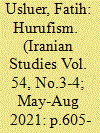

|
|
|
|
|
| Summary/Abstract |
In Hurufi history, the identity of Faḍlallāh’s children is a controversial subject. Although the Hurufi writings provide information on Faḍlallāh Astarābādī, the information related to his family has been analyzed incorrectly. More than ten different names for Faḍlallāh's children are in circulation. This lack of clarity prevents the precise historical analysis of his children. This article shares new findings regarding the Faḍlallāh family using a unique copy of Faḍlallāh’s genealogy, which provides a list of his children and grandchildren. Other sources, including Faḍlallāh’s testament, the Maḥramnāma, and primary Hurufi sources, are also considered. This article reveals Faḍlallāh’s four children, only three of whom were alive when he died, and the roles played by Faḍlallāh’s family at the time of Shāhrukh and Jahānshāh.
|
|
|
|
|
|
|
|
|
|
|
|
|
|
|
|
| 5 |
ID:
178771


|
|
|
|
|
| Summary/Abstract |
In February 1617, Jan Lucasz. van Hasselt arrived in Persia accompanying Pietro Della Valle (1586–1652), a Roman noble. Sometime between 1618 and 1621 Van Hasselt entered the service of Shah ʿAbbas I (r. 1588–1629), for whom he worked as a painter until the death of the shah. Later, during the reign of Shah Safi I (r. 1629–42) and until 1654 he tried to establish himself as a commercial agent for Persia. The present paper examines the career of this Dutch painter in Persia and the Netherlands. Meanwhile the artworks that may be attributed to him will be discussed.
|
|
|
|
|
|
|
|
|
|
|
|
|
|
|
|
| 6 |
ID:
178769
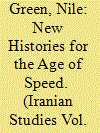

|
|
|
|
|
| Summary/Abstract |
By conceiving two emergent nation-states as a single region linked by conjoining roads, shared technologies and circulating researchers, this essay traces the emergence of a common “intellectual infrastructure” that during the interwar decades enabled European, American, Iranian, Afghan and Indian scholars to promote archeological and architectural interpretations of the Iranian and Afghan past. Taking Robert Byron’s Road to Oxiana as a fixed point of reference, the following pages survey the motor-linked sites where these new disciplinary approaches were developed and disseminated. By positioning Byron amid a larger cadre of investigators publishing in Farsi, Dari and Urdu no less than English, French and German, the essay shows how shifts in Iranian perceptions of the ancient and medieval past were part of a larger regional development, unfolding not only in familiar dialogue with Europe, but also in conversation and to some degree competition with nationalist scholarship in Afghanistan and India. Together with the journals, museums, learned societies and congresses which were launched in the 1920s and 1930s, cars and cameras—those key tools of the “age of speed”—were central to these learned ventures. Far from generating uniformity, this shared intellectual infrastructure enabled multiple interpretations of the archaeological and architectural past that were nonetheless mutually intelligible and methodologically consistent.
|
|
|
|
|
|
|
|
|
|
|
|
|
|
|
|
| 7 |
ID:
178777
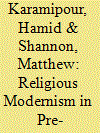

|
|
|
|
|
| Summary/Abstract |
The advent of “modern” education in Iran and its acceptance by political and cultural elites dates to the Qajar era. But the elitist nature of state reforms prevented modern education from spreading throughout society until the Pahlavi era. Especially during the reign of Mohammad Reza Shah Pahlavi, modern education reached most segments of the population, including religious families from the middle classes. This research is based on Persian-language documents and informed by the English-language historiography. The article finds that the Islamic Education Society (Jāmeʿeh-ye taʿlimat-e eslāmi) propagated religious modernism through a national network of private schools beginning in the 1940s. In the 1950s and 1960s private cultural foundations used the Islamic Education Society’s model to establish the Alavi, Kamāl, and Refāh schools in Tehran. The network that supported them was a reflection of the revolutionary movement and a vehicle for its organization by the 1970s.
|
|
|
|
|
|
|
|
|
|
|
|
|
|
|
|
| 8 |
ID:
178775
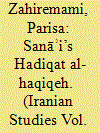

|
|
|
|
|
| Summary/Abstract |
This paper explores the unity of the Hadiqat al-haqiqeh, a medieval mystical didactic work composed by the twelfth-century Persian poet Sanāʾi. It provides one possible reading from the text by following the link between some of the major themes discussed in its chapters. By doing so, the paper first challenges the common view of the work as a fragmentary, non-narrative text, and second it draws attention to the synthesis of political ethics and Sufi didacticism as a possible starting point in the interpretation of the work. It also highlights the possibility—and necessity—of further scholarly inquiry into the Hadiqeh, regardless of issues caused by its complex textual history.
|
|
|
|
|
|
|
|
|
|
|
|
|
|
|
|
| 9 |
ID:
178774
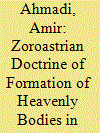

|
|
|
|
|
| Summary/Abstract |
This article is about the doctrine of the formation of celestial bodies in Pahlavi texts. The doctrine is peculiar. It clashes not only with the accounts of the Gāϑā and the Younger Avesta but also with the general cosmology of Pahlavi literature. Nonetheless it must be authoritative since it is found in our main sources of Zoroastrian (Pahlavi) cosmogony and there does not seem to be an alternative account of the formation of celestial bodies. It thus prompts us to look for its background. This article presents and discusses the texts that contain the Pahlavi doctrine, examines its Avestan roots, and shows the influence of Presocratic cosmogonic speculations on the doctrine. Further, comparative material allows us to propose a conceptual genealogy of the basic constituents of the doctrine.
|
|
|
|
|
|
|
|
|
|
|
|
|
|
|
|
|
|
|
|
|